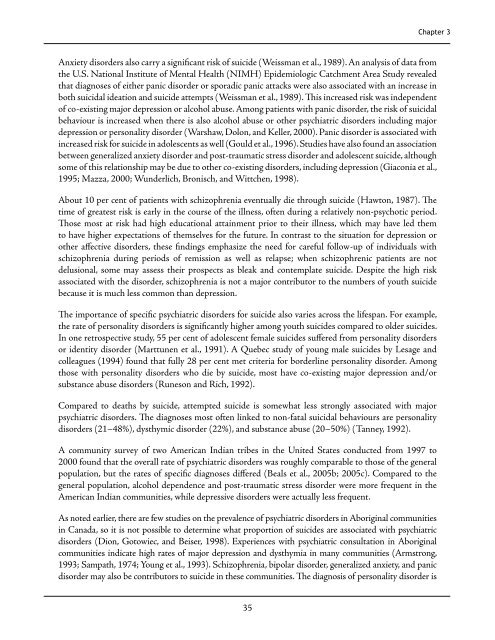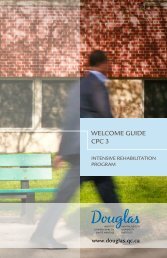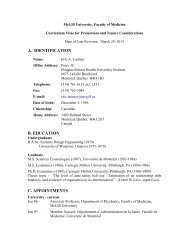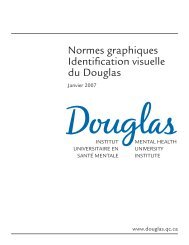Suicide Among Aboriginal People in Canada - Institut universitaire ...
Suicide Among Aboriginal People in Canada - Institut universitaire ...
Suicide Among Aboriginal People in Canada - Institut universitaire ...
Create successful ePaper yourself
Turn your PDF publications into a flip-book with our unique Google optimized e-Paper software.
Chapter 3Anxiety disorders also carry a significant risk of suicide (Weissman et al., 1989). An analysis of data fromthe U.S. National <strong>Institut</strong>e of Mental Health (NIMH) Epidemiologic Catchment Area Study revealedthat diagnoses of either panic disorder or sporadic panic attacks were also associated with an <strong>in</strong>crease <strong>in</strong>both suicidal ideation and suicide attempts (Weissman et al., 1989). This <strong>in</strong>creased risk was <strong>in</strong>dependentof co-exist<strong>in</strong>g major depression or alcohol abuse. <strong>Among</strong> patients with panic disorder, the risk of suicidalbehaviour is <strong>in</strong>creased when there is also alcohol abuse or other psychiatric disorders <strong>in</strong>clud<strong>in</strong>g majordepression or personality disorder (Warshaw, Dolon, and Keller, 2000). Panic disorder is associated with<strong>in</strong>creased risk for suicide <strong>in</strong> adolescents as well (Gould et al., 1996). Studies have also found an associationbetween generalized anxiety disorder and post-traumatic stress disorder and adolescent suicide, althoughsome of this relationship may be due to other co-exist<strong>in</strong>g disorders, <strong>in</strong>clud<strong>in</strong>g depression (Giaconia et al.,1995; Mazza, 2000; Wunderlich, Bronisch, and Wittchen, 1998).About 10 per cent of patients with schizophrenia eventually die through suicide (Hawton, 1987). Thetime of greatest risk is early <strong>in</strong> the course of the illness, often dur<strong>in</strong>g a relatively non-psychotic period.Those most at risk had high educational atta<strong>in</strong>ment prior to their illness, which may have led themto have higher expectations of themselves for the future. In contrast to the situation for depression orother affective disorders, these f<strong>in</strong>d<strong>in</strong>gs emphasize the need for careful follow-up of <strong>in</strong>dividuals withschizophrenia dur<strong>in</strong>g periods of remission as well as relapse; when schizophrenic patients are notdelusional, some may assess their prospects as bleak and contemplate suicide. Despite the high riskassociated with the disorder, schizophrenia is not a major contributor to the numbers of youth suicidebecause it is much less common than depression.The importance of specific psychiatric disorders for suicide also varies across the lifespan. For example,the rate of personality disorders is significantly higher among youth suicides compared to older suicides.In one retrospective study, 55 per cent of adolescent female suicides suffered from personality disordersor identity disorder (Marttunen et al., 1991). A Quebec study of young male suicides by Lesage andcolleagues (1994) found that fully 28 per cent met criteria for borderl<strong>in</strong>e personality disorder. <strong>Among</strong>those with personality disorders who die by suicide, most have co-exist<strong>in</strong>g major depression and/orsubstance abuse disorders (Runeson and Rich, 1992).Compared to deaths by suicide, attempted suicide is somewhat less strongly associated with majorpsychiatric disorders. The diagnoses most often l<strong>in</strong>ked to non-fatal suicidal behaviours are personalitydisorders (21–48%), dysthymic disorder (22%), and substance abuse (20–50%) (Tanney, 1992).A community survey of two American Indian tribes <strong>in</strong> the United States conducted from 1997 to2000 found that the overall rate of psychiatric disorders was roughly comparable to those of the generalpopulation, but the rates of specific diagnoses differed (Beals et al., 2005b; 2005c). Compared to thegeneral population, alcohol dependence and post-traumatic stress disorder were more frequent <strong>in</strong> theAmerican Indian communities, while depressive disorders were actually less frequent.As noted earlier, there are few studies on the prevalence of psychiatric disorders <strong>in</strong> <strong>Aborig<strong>in</strong>al</strong> communities<strong>in</strong> <strong>Canada</strong>, so it is not possible to determ<strong>in</strong>e what proportion of suicides are associated with psychiatricdisorders (Dion, Gotowiec, and Beiser, 1998). Experiences with psychiatric consultation <strong>in</strong> <strong>Aborig<strong>in</strong>al</strong>communities <strong>in</strong>dicate high rates of major depression and dysthymia <strong>in</strong> many communities (Armstrong,1993; Sampath, 1974; Young et al., 1993). Schizophrenia, bipolar disorder, generalized anxiety, and panicdisorder may also be contributors to suicide <strong>in</strong> these communities. The diagnosis of personality disorder is35
















